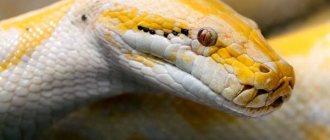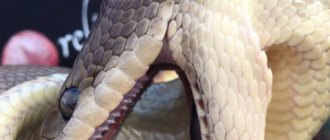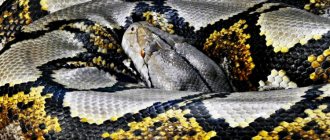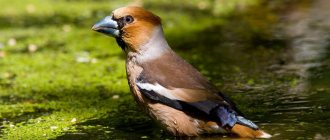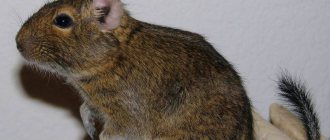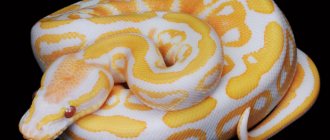Having seen a photo of a tiger python, or heard its description, many are inspired by the idea of looking at the giant. The truly huge size and beautiful patterned color make the snake unforgettable. But this power is also frightening. Although breeders are aware of the python’s quiet disposition and good survival rate in captivity. What does a tiger python look like?
In the family of non-venomous huge snakes, there are 13 genera and 68 species.
History of the origin of the species
Pythons are some of the most impressive snakes in the world. There are many different species of these large reptiles.
The tiger python comes from a genus of true pythons. Latin name: Python molurus. In some countries it is called the Indian or Burmese python. This species is divided into 2 subspecies:
- Light tiger python (Python molurus)
- Dusky tiger python (Python molurus bivittatus)
Although the status of the subspecies is still discussed and disputed.
6 meters is the average length of a tiger python.
Some herpetologists distinguish subspecies depending on the habitat of the tiger python:
- Indian
- Ceylon brindle
- Dark brindle
The origin of the name “python” is interesting. It is believed that the animal was named after the dragon Python. According to legend, the ancient Greek god Apollo defeated this dragon in a duel. A fierce battle took place near the place where the Delphic Temple was later built. After a while, the travelers saw a huge snake. And, without hesitation, they called her a mythical name.
The species is called brindle because of its color. The python's skin color resembles that of a tiger.
Aquaria2.RU
When choosing a reptile for home keeping, novice terrarium keepers usually do not consider the possibility of purchasing pythons, preferring smaller or brighter representatives of the scaly world, such as chameleons, iguanas, geckos and others, unaware of the problems they may encounter without sufficient experience. contents in the future. After all, the bulk of reptiles offered on the Russian market are imported from their native countries, practically from nature, at best from farms and breeding grounds located in the open air, where they are kept and bred practically on “free grazing”, and the sanitation and quarantine of animals are , to put it mildly, not at the proper level. Animals bred in captivity, in compliance with sanitary rules, usually cost an order of magnitude more, due to better health and appearance, high-quality rearing and smaller batches. Such animals usually end up in the terrariums of hobbyists from Europe and the USA, because... a civilized market has already developed there and more stringent requirements are imposed on imported wildlife objects.
Photo 1. Natural coloring of the dark tiger python Python molurus bivittatus
Photo 2. Albino coloration of the dark tiger python P. m. bivittatus "Albino"
Photo 4. Python P. m. bivittatus eating a rat
Photo 5. Python mating: female P. m. bivittatus and male P. m. bivittatus "Albino". With this pairing, heterozygous babies are obtained. Each of them, colored like natural individuals, will carry the gene of an albino male. With subsequent crossing with each other, it will be possible to obtain P. m. in their offspring. bivittatus "Albino"
Photo 6. Oviposition by female P. m. bivittatus. At the moment of laying eggs, the female falls into a trance. After each egg was laid, it, which had not yet taken the correct shape, was immediately placed in a tray in the incubator
Photo 8. Exit of pythons P. m. bivittatus begins 24 hours after the first eggs hatch
As a rule, the terrariums of newcomers from Russia end up with insufficiently quarantined, or even simply obviously sick, animals. Ignorance of living conditions and lack of information about reptiles also leads to illness and, as a consequence, to the death of reptiles among novice terrarium keepers. Hence the declining interest in keeping reptiles in general: they say, “this is an expensive, complex and dark business”: In fact, everything is different if you purchase an animal from breeding from a reliable manufacturer.
When I am asked what animal a beginner terrariumist should get, I usually name no more than a dozen species, and at the top of this list is the Dark Tiger Python Python molurus bivittatus - the most, in my opinion, problem-free pet for a beginner. I will give several arguments in favor of this choice. Firstly, we breed quite a lot of them, so there is no point in exporting these pythons from nature, which means that their health is usually fine. And the proper appearance of an “exotic animal” is present in it. There are several color options for pythons, so you can choose according to your taste. He is not demanding in care and feeding, he is kind in nature, he gets used to your hands quickly, which means you can surprise your friends and acquaintances. It is not without reason that circus performers and photographers from all over the world have chosen these animals for their work. In Europe and the USA, the tiger python is in the top three among reptiles for home keeping, sharing the “pedestal” with the red-eared slider and green iguana, and in the countries of Southeast Asia it is generally domesticated and used in garden plots as a “house cat” for extermination of rodents.
So, who are they - tiger pythons? Three subspecies of these reptiles are known. The Indian light tiger python Python molurus molurus is a medium-sized snake, usually not exceeding 4 meters, but six-meter specimens are also known. Distributed in Pakistan, India, Bangladesh. The coloring of this subspecies is lighter than the other two. Due to the intensive development of natural habitats, the range of the Indian python has sharply decreased. Currently, these pythons are found mainly in sanctuaries and national parks in south and southeast India. The Indian light tiger python is protected by law, included in the national and international Red Books, and in the first appendix of CITES. Its breeding in captivity has been mastered, but it is still extremely rare in amateur terrariums.
Ceylon tiger python - Python m. Pimbura is the smallest of the tiger pythons. Usually its length does not exceed 2-3 meters. Outwardly similar to the Indian light tiger python, with which it was previously united into one subspecies. It differs from the Indian one, in addition to the size, in the shape of the head. Python m. pimbura is endemic to the island of Sri Lanka (Ceylon), inhabiting the few forests and jungles that have remained intact. Included in the national and international Red Books, and in the second appendix of CITES. Due to its small size, it is a desirable species to keep for terrarium lovers, but it is quite expensive and rare. Bred in captivity.
And finally, the Dark Tiger Python - P. m. bivittatus is the largest, brightest and most common python from this group in the collections of zoos and terrariums (photo 1). Darker in color than other subspecies (hence the name), it inhabits the mountain rain forests of Southern China, Vietnam, Cambodia, Northern Thailand, Laos, and Burma. The “mountain Burmese python” belongs to this subspecies. The mountains rise to 1800 m above sea level. It reaches a length of up to 7 m, but in a terrarium it usually does not exceed 4-5 m, and some morphs are even less. P. m. bivittatus is included in the second CITES appendix. Currently, there are quite a lot of morphs and color variations of this python in the world. The most famous in Russia are the albino form “Albino” (photo 2), and the less common “Green Patternless” (photo 3). The “Granite” form is occasionally produced by python breeders, and the “High Orange Albino” form is very rare.
The conditions of keeping and breeding for all morphs and variations of the dark tiger python are identical. They are kept in horizontal terrariums. The dimensions of the terrarium must correspond to the size of the animal. Twigs and branches for climbing are highly desirable, especially for young pythons, but you can do without them. It is necessary to arrange a small pool or drinking bowl in the terrarium, but such that the animal cannot knock it over. Pythons love to lie in water, especially during molting. In order for the animal to choose the optimal temperature conditions for itself, to warm up or cool down if it wishes, the terrarium must have two zones: heated and unheated. In the heated zone of the terrarium, it is necessary to equip lower and upper local heating. The bottom heating should have an area no less than the area occupied by a coiled python. It must be connected via a thermostat. For overhead heating, you can use any heat source; sometimes a mirror lamp with a power of no more than 100 W is enough. The lamp power depends on the volume of the terrarium and is selected experimentally. The overall optimal air temperature in the terrarium is 24-25°C; in the heated zone, the daytime temperature should be around 30-31°C, and the night temperature should be at least 28°C. Bottom heating must be turned on 24 hours a day. Good ventilation must be organized in the terrarium. You can also use regular paper as a primer for pythons, but a fleecy “artificial grass” mat is much more aesthetically pleasing. The terrarium must be kept clean. After each bowel movement of the animal (usually every 7-10 days), it is necessary to change the bedding or hygienically wash the rug.
It is advisable, and even useful, in the warm season in sunny weather at an air temperature of at least 25°C to give pythons “walks” outside, 2-3 times a week for 15-30 minutes, to receive a dose of natural ultraviolet radiation. It is not advisable to specifically install a UV lamp in a terrarium, since in nature animals lead a nocturnal and sedentary lifestyle, hiding during the day in dark places inaccessible to sunlight - in burrows, under snags, in rock crevices, in leaf litter, and only occasionally crawling out in the sun to warm up.
Young pythons are fed once every 7-10 days, adults - once every 10-20 days, with food items of appropriate size: mice, rats, guinea pigs, rabbits, birds (photo 4). Typically, pythons are not picky eaters and will absorb any food offered to them that is suitable in size, but sometimes there are “picky eaters” with narrow food preferences. For example, there are specimens that do not feed on anything other than birds, so when purchasing a python you need to inquire about its taste preferences. Sometimes teenage pythons and adult animals can refuse food and starve for 1-6 months without harm to their health. This may be due to imitation of natural seasonality, wintering, molting, sexual behavior and other reasons. Such periodic “hunger strikes” should not be a cause for concern if the animal is healthy. If at the same time the python begins to lose weight, then it is better to consult a veterinarian. After 3-7 feedings, pythons usually begin molting. At the same time, their color becomes dull, their eyes and skin become cloudy, as if covered with a milky white coating: Usually, molting lasts 1-2 weeks. At this point, animals may refuse food, and it is better not to feed them. During molting, the terrarium and the animal must be moistened abundantly. Usually, immediately before changing its skin, the python’s color becomes brighter again, it seems to “lighten.” After molting, the crawl (shed skin) must be removed from the terrarium to prevent the development of unwanted pathogenic microflora on it, causing mycoses of reptiles. The humidity in the terrarium after molting can be reduced. Immediately after changing the skin, animals can be offered food.
Pythons grow quite quickly, and by 2.5-3 years, with a size of 2-3 m, they reach sexual maturity. After imitating natural seasonal changes, pythons develop sexual behavior. When the sexual partners are ready, mating is usually observed within 1-4 hours after being placed in the same terrarium. At the same time, the female raises her tail upward, and the male, clinging to the claws of his rudimentary hind limbs, entwines the female’s tail (photo 5). Mating duration is from 20 minutes to 2 hours. After successful mating, the partners are seated. After fertilization, the female can eat 1-2 more times, after which she refuses food for the entire period of pregnancy and egg incubation. The male also, as a rule, does not eat during the entire period of sexual activity. Usually 2-3 weeks after mating, the female ovulates. During this process, she turns on her side or back and lies motionless for several hours. This process serves as additional confirmation for the terrarium owner that the mating was successful. Pregnancy lasts about 60 days. Before laying eggs, the female becomes restless and looks for a place suitable in temperature and humidity. A month before the expected date of laying eggs for the female, it is advisable to place a nest house in the terrarium with a side or top entrance, partially filled with hygroscopic moistened litter (shavings, sphagnum moss or coconut chips). The size of the house is selected so that she can comfortably fit in it on the bedding along with the masonry. Laying usually begins at night (photo 6). From the beginning of laying the first egg to the completion of the clutch, 12-48 hours usually pass. The female lays on average 15 to 50 leathery, oblong white eggs measuring approximately 110 x 75 mm (photo 7). Pregnancy itself, the process of laying eggs, as well as incubation of the clutch is very difficult for the female, significantly exhausting her strength, she becomes lethargic and physically exhausted. If not properly cared for, this can even lead to death, so you should try to create the most comfortable conditions for her, protect the expectant mother from unnecessary stress (vibration, bright and harsh light, etc.), and disturb the female with your presence as little as possible.
The eggs can be left for the female to incubate naturally or placed in an incubator. After laying eggs, the female wraps herself around the clutch, guards and incubates it for 59-60 days. At the same time, she herself regulates the temperature of incubation of eggs, either tightly wrapping the eggs and rhythmically contracting the muscles of the whole body for heating, or, on the contrary, opening the clutch for ventilation and cooling. During the incubation period, the female becomes more aggressive and excitable. If the clutch is placed in an incubator, the incubation temperature should be maintained at 29-32°C. It should be noted that the yield of young pythons from eggs left for the female to incubate is much less than from eggs placed in an incubator. After the first cut in the egg membrane, the newborn babies still remain inside the egg for up to a day and a half. The emergence of juveniles is long and takes about three days (photo 8). After hatching from the eggs, young pythons are about 40 cm in size and are quite independent from the first days of life. For ease of observation and feeding of young pythons, it is better to seat them one at a time. After 7-10 days they undergo their first moult, after which they can begin to be fed. The first food is teenage mice or blind rat pups.
Anatomical features
The length of tiger pythons is from 2 to 4 m. Some of them grow more than 7 m. A python can weigh up to 130 kg.
Males are smaller than females. Males are distinguished by enlarged anal spurs.
The tiger python is a strong and muscular snake. The head is slightly triangular in shape. You can clearly see the transition of the head to the cervical region.
Due to the fact that the eyes are attached to the side of the head, the snake has a large field of vision (more than 135 degrees). Although the python sees poorly.
Interesting! Pythons have a unique jaw structure. It is weakly attached to the skull. While eating, the predator covers its prey with one jaw. The other jaw, or rather the teeth located on it, holds the prey. By alternating between gripping with the teeth and tension with the jaw, the snake completely swallows the food.
Pythons are distinguished from other snake species by having two functioning lungs and vestigial hind limbs. These limbs look like spurs on either side of the cloaca.
Heart
The already rather large organ of the tiger python increases by 40% in the first 24-72 hours after eating. This is similar to how athletes gain muscle when playing sports. The unusual properties of the heart have interested specialists.
A new study by scientists shows that the huge amounts of fatty acids that circulate in the bloodstream of a feeding python promote healthy heart growth. Certain combinations of this giant's fatty acids may have beneficial effects on heart health in all living organisms.
Professor Leslie Leinwand,
University of Colorado Boulder
Sense organs
The sense of smell, sense of temperature and Jacobson's organ are better developed than vision. Python perceives infrared radiation from heat sources. Various sense organs are located on the headplates of snakes. With their help, the python detects warm-blooded mammals and birds. There are special receptors on the head. These receptors help the snake detect temperature changes from 0.003˚ C.
Color
The main colors of python skin range from light brown to brown. A rectangular mosaic pattern on the skin runs along the entire length of the animal. The ventral side is cream colored. There is a brown stripe between the nose and eyes. This makes the animals very easy to identify.
Description
This non-venomous large snake of the python family, its length ranges from 1.5 m to 4 m. The longest specimen reached 4.6 m and weighed 52 kg. Females are more massive than males.
Colors may vary. Usually, dark brown spots of various shapes are scattered throughout the body of this snake on a lighter background of yellowish tones. This creates an interesting complex pattern, somewhat similar to the skin of a leopard, only with larger spots.
A dark stripe runs through the eyes and stretches from the nostrils to the spots on the neck. Another strip is directed from the eyes downwards and wraps up, passing along the upper lip. On the top of the head there is a dark spot, similar to an arrowhead, somewhat blurred in front.
In the center of the lateral spots there are light eyes. There are noticeable stripes on the sides of the head, pink or with a red tint. There are albino specimens.
Find out what the character of the corn snake, milk snake, and sand boa is.
Features of character and lifestyle
Even wild individuals of this species are not aggressive. When bored or disturbed by people or animals, pythons hiss, crawl away or hide. If this is unsuccessful, they try to get rid of the troublemaker with vigorous and painful defensive bites. However, most animals rarely become irritated. More often than not they crawl away.
The Indian python is inactive. But he can climb trees. Therefore, buyers are recommended to install the branch in the terrarium. The pet loves to lie on it.
The active time of tiger pythons is night or twilight. Movement during the day depends on the ambient temperature. When there is a temperature difference, the python begins to look for a place with a pleasant, constant microclimate.
Interesting! In water, huge snakes move faster and more agile than on land. When swimming, they stick only the tip of their nose out of the water. Individuals living near a reservoir lead a semi-aquatic lifestyle.
These skilled swimmers can remain underwater without breathing for up to 30 minutes.
If the winter in the habitat is cold, the python sleeps. Hibernation can last from October to February. Sometimes pythons are simply hiding from the cool temperatures.
Home improvement
First of all, before such an important step as buying an exotic animal, you need to equip it with a home . It is necessary to remember that the home should be comfortable, and most importantly, reliably protect the pet from escaping. The dimensions of the home should be as comfortable as possible for the python; the python should move around in it. Experts do not recommend huge terrariums, as it is problematic to maintain the required temperature and humidity in them. These reptiles spend almost all their time on the ground, so height is not as important as, for example, the area of the home.
The home must be equipped with a door so that the pet can get out if necessary. But the door must have a lock, this will help protect the pet from escaping.
Ventilation must be mandatory, an influx of fresh air is mandatory for any living creature. Usually this problem is easily solved by small holes on the sides of the terrarium.
The most acceptable materials for making a house for a snake are wood, durable plastic or glass . These are the most convenient materials; they are easy to clean and disinfect.
Air temperature is also important. Pythons' favorite temperature is 27 degrees Celsius. At night you can make it a little cooler than usual. To provide the required level of heat, you can use special aids sold at pet stores: heating pads, warming film and lamps.
Popular morphs of tiger pythons
New morphs of different snakes are born every year. The tiger python is no exception. Some minor variations in color resulted from natural mutations. But representatives of bright morphs (granite, albino) are the result of selection work.
New variations in skin color are obtained not only for aesthetic pleasure. In the 80s, breeders received a lot of income from breeding and crossing tiger pythons.
Albino
The albino Burmese python is the first morph.
Its peculiarity: the python is completely devoid of dark pigment. Albino skin is light with yellow-orange patterns. The albino variation is considered a color mutation and is becoming increasingly popular among hobbyists.
Green
The “green” morph appeared in 1987.
The cubs are khaki with a silver tint on the sides. There is a dark brown line on the back.
Adults darken. The spots are no longer noticeable on the base olive-green skin color.
Labyrinth
It is assumed that the labyrinth-colored python appeared naturally in the 80-90s.
Labyrinth tiger pythons have dark skin color with intricate patterns. It is thanks to the unusual pattern of the morph that it is called a “labyrinth”. In 1993, a python of this morph was crossed with an albino python. The result was a beautiful white snake appearance with gold designs. One of the most desirable tiger python morphs.
Reproduction
With proper care, the tiger python reproduces well in captivity. The female of this large species of snake is considered one of the best mothers among reptiles. After the mating period, she lays eggs (8-50 pieces), their number depends on the size and age of the expectant mother.
Having made a clutch, the mother wraps herself around it and begins incubation. The incubation period ranges from 70 to 80 days at a temperature of about 30 degrees. The temperature regime is maintained thanks to the muscle contractions of the tiger hen. In due time, small pythons are born 40-60 cm long.
Where does the tiger python live?
The tiger python is native to the tropical forests of Southeast Asia. Most often found in:
- India,
- Myanmar,
- Bangladesh,
- Pakistan,
- Southern China (especially Sichuan),
- Indonesia,
- Sri Lanka.
Tiger pythons have taken root well and spread throughout the United States. For this country, the python is an invasive species. That is, introduced and spread by humans. Tiger pythons were popular as pets in the 1980s and 1990s. Today, snakes have lived in the United States for several generations and are considered native.
Distribution of tiger pythons in the United States
When the pets grew up and showed themselves in all their gigantic beauty, many Americans simply released them into the wild. The pythons quickly spread throughout the state's wilderness areas and parks. Many of them also appeared in the Everglades National Park. This park has been researching ways to remove pythons from the environment for over 10 years.
Finding and mapping tiger python habitats in Everglades National Park (Florida)
Pythons prefer wetlands, swampy forests, tropical or subtropical forests, grassy swamps and swampy savannas. Always close to a body of water. During its resting period, the snake stays in dense vegetation.
Behavior
Reptiles live mainly in tropical and subtropical forests. Much less often they are observed in bushes and peasant fields. Snakes choose areas located near water bodies for their place of residence.
They lead a terrestrial lifestyle; at a young age they can crawl into trees. Sometimes they are observed in the upper tiers of the forest. Near rivers and lakes, reptiles spend most of their time in water. They swim well and move much faster in the aquatic environment than on a solid surface.
When swimming, tiger pythons leave only the tip of their muzzle with nostrils above the water. They dive often and can hold their breath for up to half an hour. Reptiles are adapted to existence in freshwater and mixed water bodies; forays into the open sea are categorically avoided.
Underground burrows, rock crevices, termite mounds, tree hollows, mangroves and thickets of tall grass are used as shelters.
In northern Pakistan, India and Burma, animals hibernate from December to February. They gather in groups and hibernate together under rocks, tree roots, or in underground shelters under a thick layer of fallen leaves.
Under unfavorable conditions, the tiger python can migrate to other territories. In one day, adult individuals are able to cover distances of up to 2.3 km on land. They are not territorial and, as a rule, do not show aggression towards their fellow tribesmen. Several animals can be in one shelter at the same time.
What does a tiger python eat?
The tiger python is a carnivore. Its diet consists of live prey. Pythons eat almost anything they can catch:
- Mammals,
- Rodents,
- Birds,
- amphibians,
- Reptiles,
- Amphibians.
Tiger pythons risk attacking even large animals: crocodiles, deer, tigers.
Python is a hunter in ambush. It lies curled up on the ground, waiting for prey. Despite its massive body, the snake quickly attacks its prey. Then it grabs the head with its teeth and wraps 2-3 rings around the prey. The python strangles the captured animal in a special way: with each exhalation of the victim, it squeezes its mouth closer. At the end, making sure that the prey is dead, it slowly swallows it. Like many snakes, the python begins to swallow from the head.
Interesting! In an animal strangled by a python, all the bones remain intact. And this despite the powerful grip of the snake.
In 2011, a Burmese python was captured in South Florida. It was a female 4.8 m long. Her weight was 100 kg. It turned out that she had swallowed the deer whole. This happened before she was caught. The weight of the deer is 64 kg.
Nutrition
The tiger python will need more and more food as it grows. First, the owner needs to decide which feeding method he will use. If you give a predator live food, then the natural hunting instincts will play in it with redoubled force. This is not always desirable, and the python’s victim may injure your pet in self-defense.
If you feed the handsome guy frozen food, then these problems will immediately disappear. The python will not be too bloodthirsty, and the possibility of injury in the heat of a hunting battle is excluded in itself.
The first feeding consists of one mouse once a week. Then the python, which reaches a length of 1.5 m, will need a larger rodent, such as a rat. When the tiger pet crosses the 2 m mark, it is recommended to use rabbits and chickens as food.
How does a tiger python reproduce?
At 2-3 years the animal reaches sexual maturity. Mating itself occurs mainly in the spring.
Tiger pythons are loners.
They never group and do not move with their relatives. Only during the mating period do males and females meet. Then they separate again. With the help of Jacobson's organ they recognize each other. The potential mate wraps itself around the female. Thus, he takes care of her. Actual copulation can last anywhere from a few minutes to half an hour. Table 2 - Key reproductive features
| Reproduction method | Maximum number of offspring | Average | Gestational age | Incubation period | Age of sexual or reproductive activity |
| Oviparous | High range. The female can lay up to 100 eggs. | On average, 40 eggs are laid. | From 2 to 4 months. | 60-90 days. | From 2 to 3 years. |
The female does not leave her clutch.
She covers and wraps the eggs with her body. In general, snakes are cold-blooded animals. But pythons found a way to warm their bodies in order to preserve their offspring. The snake contracts its muscles in a rhythm similar to trembling. This generates the heat necessary for incubation. During this period, the female tiger python does not eat. When the cubs appear, they immediately come to their senses. But they remain in the shell for a short time.
Interesting facts about the large snake
There is very interesting information about tiger pythons that will be useful to know for every person who has decided to place such a reptile in captivity at home:
- The presented snakes never bite the victim they have decided to make their lunch. They entangle it with their body and squeeze until the animal stops breathing. Only the reptile completely swallows already dead prey.
- Under natural conditions, the snake’s favorite “delicacy” is caimans, antelopes and monkeys.
- Today, people actively hunt pythons for their beautiful skin, from which they make a variety of wardrobe items. Most often - bags and wallets.
Tamed individuals, who grew up at home from birth, always turn out to be less aggressive and more friendly than their “wild” counterparts.
Natural enemies of snakes
Humans are one of the main enemies of tiger pythons. The skin of these giants is highly prized in the fashion industry for its exotic appearance. Therefore, there is trapping and a large volume of trade export of animals.
Catching a tiger python
In its native range, the python is also hunted as a food source. For centuries, tiger python meat has been consumed in Asian countries. And eggs were and are considered a delicacy. Animal entrails are important to traditional Chinese medicine.
In addition, especially in youth, animals such as:
- King Cobras,
- Indian mongooses,
- Tigers,
- Leopards,
- The Bears,
- Some birds of prey (for example, black milan),
- Bengal monitor lizard.
Is it worth maintaining - all the pros and cons
Pythons are noble animals with amazing colors. Therefore, there are many people who collect them.
- Pythons are quite calm animals, some of the species are tame, for example, tiger and reticulated.
- Almost no smell.
- They don't make nasty sounds.
- They are not at all slippery to the touch, as many are accustomed to thinking.
- They do not need to be fed every day, only once every 1-2 weeks.
If you have no fear of snakes, then keeping a python will not be difficult for you. Caring for them is not that difficult.
Population and species status
It is known that large populations of the tiger python in the countries where it lives (India, Bangladesh) were noticed at the beginning of the 20th century. And then the catching of huge snakes began. Up to 15,000 skins were exported from India to Japan, Europe and the USA annually.
Tiger python skin material
The number of tiger pythons is noticeably declining. This is influenced by both factors common to all animals and factors associated only with this species:
- Reduction of natural habitat area. Deforestation, fires, development of habitual places of life of pythons.
- Eating snake meat. Eggs are also a delicacy.
- The use of python organs in traditional medical therapy in some countries. For example, in China.
- Capturing large numbers of pythons for their skins. Active use of this material in the leather industry. What brings economic benefits to countries.
The latter point played a major role in the decline in the population of the species. In some areas this led to the complete extinction of animals.
In this regard, in the countries of the habitat (but still not in all) protective measures have been taken:
- The export of pythons from the country was banned in India in 1977.
- Trade in pythons was restricted to protect the species in Thailand in 1985. The annual sales limit was 22,000 skins.
In Laos, Cambodia and Vietnam, the leather industry is still involved in the ongoing decline of pythons.
Feeding and care
It is very convenient for owners that such pets do not require frequent feeding. After its next meal, the owner of the snake can forget about this responsibility for about a week. When a python grows to adulthood, it is fed even less frequently - once every 10–11 days. To begin with, live or frozen mice are suitable as the main treat.
It is very important to feed such snakes with animal food.
For young animals that have just hatched from eggs, experts recommend taking very small rats or mice. When a python grows to 1 meter, you can begin to include adult mice in its menu. After reaching a size of 3 meters, even large rodents can be used for feeding. Special supplements with a high content of vitamins and minerals will also be useful.
It often happens that in the period after the age of 1 month and up to six months, the tiger python suddenly begins to deliberately starve
It is very important to find the reason for such a “strike”. Most often this occurs due to hibernation, molting or pregnancy.
If the refusal of food is natural, then the snake will not lose weight. When its volumes nevertheless decrease, you should definitely contact a veterinarian.
It is very important to properly set up a terrarium for your reptile. It must be horizontal with a height of at least 70 cm
The length and width depend on the size of the snake. The following parameters are considered optimal: 200 by 100 cm. The specified height is convenient for all python care activities. For example, for regular cleaning.
Watch this video on YouTube
For adults, you should not take a “house” made entirely of glass. They can easily break such a structure by pressing their nose and tail into opposite ends and springing back. The best option is a terrarium made of combined materials. For example, a combination of plastic, glass and wood. The reliability of the locks is no less important. The tiger python is able to open even the most durable lids with ease. But we must not forget about ventilation. Usually, just small holes in the walls of the structure are sufficient.
Torn newspapers or wood sawdust work well as bedding for the bottom of a snake’s home. Today you can buy special mats for snake terrariums in pet stores. They do not need to be changed often, just wash/wash them regularly. But sawdust or newspapers must be replaced with new ones as they become dirty.
The species of pythons under discussion is most comfortable living in high humidity. Optimal parameters are from 60 to 90 percent. Frequent spraying of the terrarium or a special rain installation will help achieve this indicator. It is advisable to place a capacious drinking bowl or even a miniature pool in the python’s home, in which it will bathe regularly. But any container with liquid must be very stable, otherwise the snake will constantly turn it over.
But this does not mean that he needs to be taken outside. It is enough to let the reptile into the room on a sunny, warm day. The air temperature in the room should not fall below 25 degrees.
If the snake is young and nervous, for the first walks you should provide a shelter in which it will feel completely safe. Later you can do without such a shelter.
Keeping a tiger python in captivity
Due to their calm nature and undemanding nature, tiger pythons are among the most suitable of large snakes to keep at home. They are purchased from breeders or in a pet store or online store.
Tiger python in a terrarium
Important! Before purchasing a python, you need to weigh the pros and cons. It is imperative to remember and understand that over time the young individual will gain weight and grow in length to a large size. It can be difficult for one person to cope with a huge snake.
How to choose a terrarium
Python terrarium designs can range from a simple glass aquarium with a lid to more complex diorama enclosures used more often for exhibitions.
Tanks with wood, metal, plastic bodies and glass panels are suitable for these large snakes.
Terrariums with pythons are found not only in zoos and private homes. They are installed to attract and entertain the public in cafes and restaurants.
In areas with mild winter climates, pythons can be kept in an open enclosure. But caring for and caring for a pet outdoors is more difficult than in closed terrariums in the house. In addition, it is more difficult to ensure the safety of outdoor enclosures.
The size of the terrarium depends on the size of the python. It is not necessary to take a huge terrarium, the size of half a room or more. The area of the pet's home should allow the snake to move around. In larger tanks it is more difficult to control temperature and humidity. Pythons are land snakes. Most often they crawl on the ground. Therefore, the floor area of their enclosure will be more important to the animal than the height of the cage.
A baby python will need 80 liters of space. And an adult weighing 90-100 kg needs a terrarium, the base area of which is no less than 2 by 4 m (90x45x45)
Tip #1. To determine the area of the terrarium, the area of the snake itself is measured when it lies in a flat ring. Increase the resulting result by 4-6 times - this will be the required housing area for the pet.
It is necessary to place a shelter in the terrarium. This is the place where the python hides from prying eyes.
What to feed a tiger python?
Feeding tiger pythons is not difficult.
- Food should have a smell like something edible.
- The food item must move in the manner of the victim.
- The food offered should be warmer than the surrounding space and objects.
Cubs need to be fed 1-2 times a week.
Small mice are suitable for this. Adult pythons should be fed less frequently to prevent obesity. Rabbits, for example, suit them well. Frozen, pre-prepared food makes feeding easier for the snake owner. It is also believed that dead food will not injure the python like struggling prey. But, you should also remember that in its natural environment, the python always eats live animals.
Pythons must always have access to water. A heavy ceramic bowl works well for drinking.
Tip #2. You should not hold pythons by the head if you need to take them from the terrarium or move them somewhere. Because the snake feels threatened by this. If this must be done, the body should be well supported. To safely handle a large specimen, 2 people are sometimes required
Humidity
Pythons come from tropical rain forests. Therefore, they need a fair amount of moisture (80-90%). Too much humidity can lead to bacterial infections. But at the same time, too low humidity causes problems with molting.
Tiger python molt
Juveniles molt frequently. The skin is shed 1-2 times a month. Adult pythons change their skin every few months. The python should not be fed before shedding its skin. The process itself usually lasts 10-14 days. Harbingers of molting:
- Muddy, whitish eyes of an animal,
- Duller skin color
- Refusal to eat.
The old skin is shed as a whole stocking. This is the best option for a snake. Sometimes the skin comes off in pieces.
Tip #3. If a python in a terrarium sheds its skin in pieces, it means that it “doesn’t like” something. We need to increase the humidity. This often happens due to the fact that the epidermis is not saturated with the required amount of moisture. The skin becomes fragile. An inconvenient (small) terrarium and the absence of elements that help with molting (stones, driftwood) can also be the cause of “ragged” molting.
Content
Before you bring a snake of such a large size into your home, you need to set up a suitable terrarium for it. The snake house must be equipped with additional heating; it is necessary to create an environment close to nature. To do this, it is enough to place branches, driftwood and stones in the terrarium. At the same time, make sure that there are no sharp corners on them that could injure your pet.
For the normal existence of a python, it regularly requires fresh water. Therefore, mini-pools and drinking bowls are necessary for animals. They also need to be installed in order to maintain high air humidity (90%) in the snake kingdom. The temperature in the terrarium should be about 27 degrees during the day and about 23 degrees at night. For heating, it is better to choose one of the branches, placing a heat source above it. Thus, the reptile will have its own comfortable and warm “sofa”. In such a resting place it should be 33-35 degrees.
Required temperature in the terrarium for an individual
One of the most important aspects of caring for a tiger python is maintaining the temperature regime in its “home”. Ideally, it is necessary to create two zones at once - with and without additional heating. But the temperature transition between them must be made very smooth, otherwise the snake may get sick. Thermal mats are well suited for lower heating, which should be constant, and mirror lamps are suitable for upper heating. During the day, the temperature of the heating zone should be 34–36 °C during the day and 28–29 at night. On average, it is necessary to maintain a temperature of 25–26 degrees.
